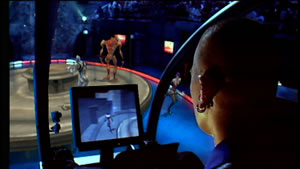Broadcasters have flirted with interactivity in quiz shows for a long time – and there have been a few examples lately using mobile phones to SMS answers. However, the BBC has teamed with Tailor Made Films to develop the next stage – proper interactivity on multiple platforms, including a mobile phone and web-based Java applets. The game can also be played on Freeview and through satellite set-top boxes.
The project has been on the go for about 18 months, and has evolved since its inception. SMS was considered in the early days, but was rejected as it was too restrictive.
Neil Pleasants, Managing Producer at Tailor Made Films told Digital Lifestyles why they favoured Java: ” Java is portable – you can take it to other countries and it’ll work. Digital TV platforms might as well be written in Martian, they don’t transfer — the platforms differ wildly as their capabilities.”
The BBC website explains the format of the quiz: “Come And Have A Go… offers viewers the chance to challenge the studio winners head to head. Playing on interactive TV, Java, or web, teams at home answer the same questions as the studio teams. At the end of the first part of the show a satellite camera is whisked off to join the top scoring home team – wherever they are in the UK. In the second part of the show, the home team competes live against the studio team for the cash prize.” The cameras are on motorbikes distributed around the country.
Neil went onto explain how Java has enabled them to sell the programme into other markets with the minimum of trouble: “We’re taking the programme worldwide. When we went into countries and explained the idea, they loved it. But they didn’t know about the actual technology. We’ve made the technology as simple as possible and that’s the key, because that is so essential everywhere.” Tailor Made films even have an idea for a branded phone.
Their first phase was getting the programme into Western Europe, America, Australia and Scandinavia – the second phase will be Eastern Europe, Middle East, Japan and China.
Java also allowed Tailor Made to build high levels of security into the quiz applet to prevent cheating, including timestamping. This is just as well: the guaranteed minimum prize is UK£30,000 (US$55,000, €45,000) the largest ever weekly prize ever given out on a British television programme.
Neil believes that content is maturing to match the platforms available: “This is as interactive as it gets.”
 Following the recent launch of Sony’s PSX, which combines the functions of a PlayStation 2, PVR and DVD burner (
Following the recent launch of Sony’s PSX, which combines the functions of a PlayStation 2, PVR and DVD burner ( After all the hype, the BBC’s virtually-virtual gameshow Fightbox [
After all the hype, the BBC’s virtually-virtual gameshow Fightbox [ over-the-shoulder shots (right) of the contestants which showed them in their pod displaying their computer monitor action in the foreground, in the middle-ground the virtual arena action and finally the real arena and audience action in the background. In another, there was a low shot from the arena floor looking up through one of the virtual challenges, the helix. Both these shots, amongst others, helped to create depth of vision, contributing a sense of scale and density to the action. At no point did the huge arena appear to be empty even though, in the “Real World” it was. (In reality, the studio audience watched the gaming on a massive screen.) I ought to mention the graphics too. Although gamers’ expectations are always increasing, visually the graphics in Fightbox are fairly good. There was a consistency between the studio lighting and the graphics which was so good that virtual shadows were created which matched the real ones. Now that’s attention to detail!
over-the-shoulder shots (right) of the contestants which showed them in their pod displaying their computer monitor action in the foreground, in the middle-ground the virtual arena action and finally the real arena and audience action in the background. In another, there was a low shot from the arena floor looking up through one of the virtual challenges, the helix. Both these shots, amongst others, helped to create depth of vision, contributing a sense of scale and density to the action. At no point did the huge arena appear to be empty even though, in the “Real World” it was. (In reality, the studio audience watched the gaming on a massive screen.) I ought to mention the graphics too. Although gamers’ expectations are always increasing, visually the graphics in Fightbox are fairly good. There was a consistency between the studio lighting and the graphics which was so good that virtual shadows were created which matched the real ones. Now that’s attention to detail!